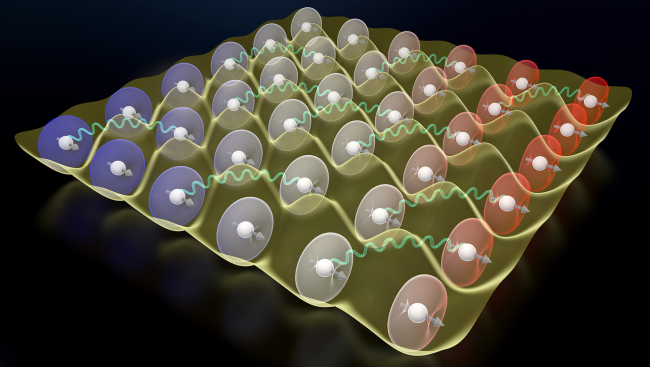Observation of millihertz-level cooperative Lamb shifts in an optical atomic clock
| Author | |
|---|---|
| Abstract |
Collective couplings of atomic dipoles to a shared electromagnetic environment produce a wide range of many-body phenomena. We report on the direct observation of resonant electric dipole-dipole interactions in a cubic array of atoms in the many-excitation limit. The interactions produce spatially dependent cooperative Lamb shifts when spectroscopically interrogating the millihertz-wide optical clock transition in strontium-87. We show that the ensemble-averaged shifts can be suppressed below the level of evaluated systematic uncertainties for optical atomic clocks. |
| Year of Publication |
2024
|
| Date Published |
2024-01
|
| Journal Title |
Science
|
| Volume |
383
|
| Issue |
6681
|
| Start Page or Article ID |
384-387
|
| ISSN Number |
0036-8075, 1095-9203
|
| DOI | |
| Download citation | |
| JILA PI | |
| Related JILA Highlights | |
| Associated Institutes | |
Journal Article
|
|
| JILA Topics | |
| Publication Status | |
| Publication Image |

|


 The Physics Frontiers Centers (PFC) program supports university-based centers and institutes where the collective efforts of a larger group of individuals can enable transformational advances in the most promising research areas. The program is designed to foster major breakthroughs at the intellectual frontiers of physics by providing needed resources such as combinations of talents, skills, disciplines, and/or specialized infrastructure, not usually available to individual investigators or small groups, in an environment in which the collective efforts of the larger group can be shown to be seminal to promoting significant progress in the science and the education of students. PFCs also include creative, substantive activities aimed at enhancing education, broadening participation of traditionally underrepresented groups, and outreach to the scientific community and general public.
The Physics Frontiers Centers (PFC) program supports university-based centers and institutes where the collective efforts of a larger group of individuals can enable transformational advances in the most promising research areas. The program is designed to foster major breakthroughs at the intellectual frontiers of physics by providing needed resources such as combinations of talents, skills, disciplines, and/or specialized infrastructure, not usually available to individual investigators or small groups, in an environment in which the collective efforts of the larger group can be shown to be seminal to promoting significant progress in the science and the education of students. PFCs also include creative, substantive activities aimed at enhancing education, broadening participation of traditionally underrepresented groups, and outreach to the scientific community and general public.